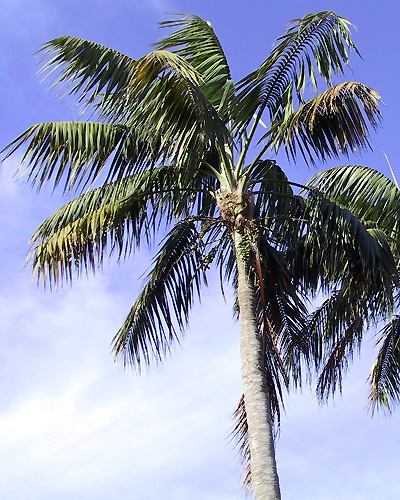
The Howea forsteriana, or Kentia Palm, is endemic to the Lord Howe Islands in the Tasman Sea about 500 mi off the eastern coast of New South Wales, Australia. This species is also called the Paradise Palm, the Sentry Palm and the Thatch Palm.
Lord Howe Island was discovered in the late 1700’s, and original islanders used the predominant tree – the Kentia Palm – for its strong, fibrous leaves as thatching for their homes. Born of volcanic activity, seven miles long , one mile wide and boomerang-like in shape, Lord Howe Island is often described as the most beautiful island in the world. The islands also feature the world’s most southerly true coral reef. It is an area of spectacular and scenic landscapes encapsulated within a small land area, and provides important breeding grounds for colonies of seabirds as well as significant natural habitat for the conservation of threatened species. Iconic species include endemics such as the flightless Lord Howe Woodhen (Gallirallis sylvestris), once regarded as one of the rarest birds in the world, and the Lord Howe Island Phasmid (Dryococelus australis), the world’s largest stick insect that was feared extinct until its rediscovery on Balls Pyramid. The Lord Howe Island Group is now an official UNESCO World Heritage Site.
Kentia Palms have been imported to Europe as early as the 1870s by seed merchants and palm cultivators. By the 1880’s, a well-organized industry had developed on the Lord How Island with the residents harvesting the seeds and sending them to Europe directly or via agents in Sydney, Australia. This seed industry provided major economic benefit for the islanders. The Kentia palm still remains Lord Howe’s only significant export, providing most of the income needed by the island administration. To this day, seed collectors still climb the trees to harvest seed in the same way as they did over 100 years ago.
The International Union of Conservation of Nature (IUCN) has this palm listed as “Vulnerable” on it’s Red List of Threatened Species. Even with it’s “vulnerable status”, the Kentia Palm is probably the most popular palm in the world and the most commonly grown indoor palm – with good reason, as this beautiful, graceful palm is incredibly tolerant of neglect, and capable of withstanding very low light situations, as well as air-conditioning.
The Kentia palm gets its name from the capital city of Lord Howe Island, Kentia, and the genus name, Howea, honors the island. The species name, forsteriana, honors New South Wales Senator Henry William Forster, who was a key in obtaining woman suffrage for Australia. Kentia.
There are 17 Kentia Palms growing in the Merwin Palm Collection today.
Want to “virtually explore” the Merwin Palm Collection? Search through our archive of Palm Facts of the Week, featuring palms hand-planted by W.S Merwin. To search through the Online Merwin Palm Database, visit this link.
If you’re inspired to help The Merwin Conservancy preserve and care for the world-renowned Merwin Palm Collection into the future, please consider making a tax-deductible donation.
Featured photo by Mike Gray can be found at the Palm & Cycad Societies of Australia website.

